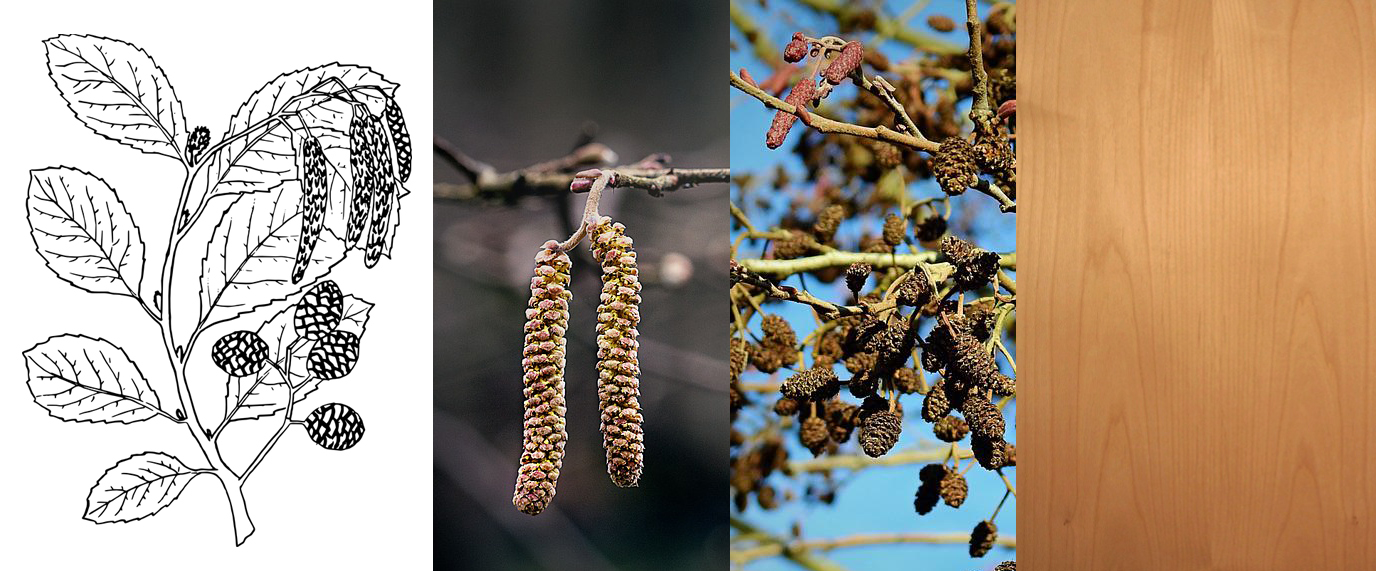Alder wood in construction

|
Contents |
[edit] Introduction
Alder (Alnus glutinosa) is grown in the UK, and Europe, used for minor utility products, sometimes available as beams.
It is native to almost the whole of continental Europe (other than the far north and south), with over 30 species in the genus Alnus. It can also be found in the Americas. The species A. glutinosa is the only one in the genus that is native to the UK.
Alders are part of the birch family (Betulaceae), but a different genera, Alnus whilst birches are of the genus Betula. It is monoecious, which means both male and female flowers or catkins are found on the same tree. Male catkins turn yellow whilst female catkins are a green, oval shape that resembles woody, tiny, cone-like fruits after pollination.
Alder grows well in moist ground near water as it thrives in damp, cool environments. The roots can help prevent soil erosion near streams, growing in marshes and wet woodlands. It can also grow in drier areas on the edges of mixed woodland, as it grows well seeded on bare ground. In wet habitats alder combined with moss, lichen and funghi, is important for moths, caterpillars, butterflies, and otters living in the roots, whilst the birds siskin, redpoll and goldfinch feed on the catkins that also provide an early source of pollen for bees.
The Grey Alder (Alnus incana) is planted in gardens and for shelter and can reach heights of up to 80ft. Although it prefers moist ground it does not tolerate water logging in the same way as the Common Alder. It is a hardier species, often used on reclaimed industrial land. This species produces highly ornamental catkins before the Common Alder and before its first leaf flush.
According to ancient belief / superstition, evil lurked in the Common Alder, because its wood appears to bleed when cut, it was feared, suggesting the tree was a malign spirit embodied.
[edit] Forestry products
As a forestry crop it has the advantage of the nitrogen-fixing bacterium Frankia alni at its roots, so it can be grown in wasteland areas with poor soils, able to improve soil quality as a pioneer species. All alders have this ability, with certain species such as the Italian Alder (Alnus cordata) being particularly effective. Alder also coppices well and is used to produce charcoal. Charcoaled Alder Buckthorn (Frangula alnus) was historically used in the production of gunpowder.
As a wood it is soft, porous and light brown in colour becoming more red with age, it is non-durable due to poor resistance to decay, however, it can be durable if kept wet, as it can withstand rotting in water. As such it has historically been used for boat construction, in sluice gates and water pipes. Today, alder wood is mainly used to make timber veneers, pulp and plywood, although some interior furniture may be made from alder as it is relatively easy to work with and has an attractive finish. Traditionally, alder branches might have been cut and placed inside cupboards to deter woodworm from laying eggs in the timber of the cupboard.
[edit] Specification
- Common Name(s): European alder, black alder, common alder.
- Scientific Name: Alnus glutinosa
- Distribution: Western Europe
- Tree Size: 65-80 ft (20-25 m) tall, 1-2 ft (.3-.6 m) trunk diameter
- Average Dried Weight: 33.3 lbs/ft3 (535 kg/m3)
- Specific Gravity (Basic, 12% MC): .41, 0.53
- Janka Hardness: 650 lbf (2,890 N)
- Modulus of Rupture: 13,260 lbf/in2 (91.4 MPa)
- Elastic Modulus: 1,596,000 lbf/in2 (11.01 GPa)
- Crushing Strength: 5,770 lbf/in2 (39.8 MPa)
- Shrinkage: Radial: 3.6%, Tangential: 7.0%, Volumetric: 11.0%, T/R Ratio: 1.9
[edit] External links
Specifications, photographs and more detailed descriptions are also available from:
- https://www.wood-database.com/european-alder/ (as above)
- https://www.woodlandtrust.org.uk/trees-woods-and-wildlife/british-trees/a-z-of-british-trees/alder/
[edit] Related articles on Designing Buildings
Featured articles and news
RTPI leader to become new CIOB Chief Executive Officer
Dr Victoria Hills MRTPI, FICE to take over after Caroline Gumble’s departure.
Social and affordable housing, a long term plan for delivery
The “Delivering a Decade of Renewal for Social and Affordable Housing” strategy sets out future path.
A change to adoptive architecture
Effects of global weather warming on architectural detailing, material choice and human interaction.
The proposed publicly owned and backed subsidiary of Homes England, to facilitate new homes.
How big is the problem and what can we do to mitigate the effects?
Overheating guidance and tools for building designers
A number of cool guides to help with the heat.
The UK's Modern Industrial Strategy: A 10 year plan
Previous consultation criticism, current key elements and general support with some persisting reservations.
Building Safety Regulator reforms
New roles, new staff and a new fast track service pave the way for a single construction regulator.
Architectural Technologist CPDs and Communications
CIAT CPD… and how you can do it!
Cooling centres and cool spaces
Managing extreme heat in cities by directing the public to places for heat stress relief and water sources.
Winter gardens: A brief history and warm variations
Extending the season with glass in different forms and terms.
Restoring Great Yarmouth's Winter Gardens
Transforming one of the least sustainable constructions imaginable.
Construction Skills Mission Board launch sector drive
Newly formed government and industry collaboration set strategy for recruiting an additional 100,000 construction workers a year.
New Architects Code comes into effect in September 2025
ARB Architects Code of Conduct and Practice available with ongoing consultation regarding guidance.
Welsh Skills Body (Medr) launches ambitious plan
The new skills body brings together funding and regulation of tertiary education and research for the devolved nation.
Paul Gandy FCIOB announced as next CIOB President
Former Tilbury Douglas CEO takes helm.
UK Infrastructure: A 10 Year Strategy. In brief with reactions
With the National Infrastructure and Service Transformation Authority (NISTA).






















